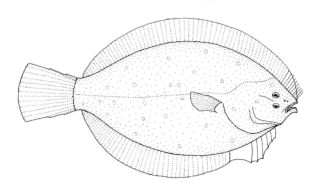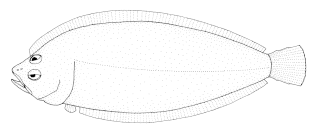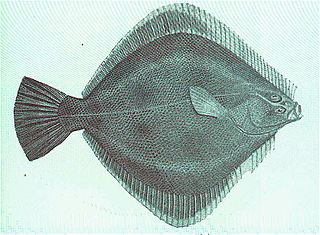
Flounders are a group of flatfish species. They are demersal fish, found at the bottom of oceans around the world; some species will also enter estuaries.
Deania is a genus of long-snouted, deepwater dogfish sharks in the family Centrophoridae.

The black flounder is a flatfish of the genus Rhombosolea, found around New Zealand in shallow enclosed waters and coastal freshwater lakes. Its adult length ranges from 20 to 45 cm.

The yellowbelly flounder is a flatfish of the genus Rhombosolea, found around New Zealand. A different species from the genus Rhombosolea is found in Australia and also goes by the name yellow-belly flounder. The Māori people have commonly fished for R.leporina, and many other species of flatfish, throughout New Zealand's coastal waters for hundreds of years. The Māori name for this species is 'patiki totara'.
The rough-head whiptail or oblique banded rattail, Coelorinchus aspercephalus, is a species of rattail found around New Zealand including islands to New Zealand's south, at depths of between 30 and 300 m. Its length is between 15 and 35 cm.

The New Zealand sole or common sole, Peltorhamphus novaezeelandiae, is a righteye flounder of the genus Peltorhamphus, found around New Zealand in shallow enclosed waters less than 100 m in depth. Their length is from 25 to 45 cm.

The crested flounder, Lophonectes gallus, is a lefteye flounder of the genus Lophonectes, found around south eastern Australia, and New Zealand in waters less than 240 m in depth. Their length is from 10 to 20 cm.

The witch, Arnoglossus scapha, is a lefteye flounder of the family Bothidae, found around China and New Zealand, in waters less than 400 m in depth. Their length is from 20 to 40 cm.

Neoachiropsetta milfordi, the armless flounder or finless flounder, is a species of southern flounder, the only member of the genus Neoachiropsetta. It is found in Antarctic and subantarctic waters, in depths of between 100 and 1,000 metres, and grows to a length of 57 centimetres (22 in)
The southern lemon sole, also known as the New Zealand lemon sole, is a righteye flounder, the only species in the genus Pelotretis, found around New Zealand in enclosed waters such as estuaries, harbours, mudflats, and sandflats, in waters less than 385 m in depth. Their length is from 25 to 50 cm.

The greenback flounder is a righteye flounder of the genus Rhombosolea, found around southern Australia and New Zealand.

The New Zealand sand flounder is a righteye flounder of the genus Rhombosolea, found around New Zealand in shallow waters down to depths of 100 m.

The greenback horse mackerel or greenback scad is a species of jack in the family Carangidae, found around western and southern Australia, and around New Zealand, from the surface to depths of 460 m. Its length is up to 64 cm.

The New Zealand turbot, Colistium nudipinnis, is a righteye flounder of the subfamily Rhombosoleinae in the family Pleuronectidae, found around New Zealand in shallow enclosed waters. Their length is from 25 to 90 cm, and they are the largest flounder in New Zealand.

The bluefin gurnard or Pacific red gurnard is a species of fish in the family Triglidae, the sea robins and gurnards. It is found in the western Indian Ocean and the western Pacific Ocean, being common around Australia and New Zealand at depths down to 200 metres (660 ft). Its length is up to 60 centimetres (24 in).
Peltorhamphus tenuis is a righteye flounder of the family Pleuronectidae, found only around New Zealand in enclosed waters less than 100 m in depth.
The speckled sole, Peltorhamphus latus, is a righteye flounder of the family Pleuronectidae, found around New Zealand and Norfolk Island in enclosed waters less than 55 m in depth. Their length is up to 17 cm.

Rhombosolea is a genus of righteye flounders. The four species in this genus can be found in the waters around New Zealand and southern Australia.

Austrovenus stutchburyi, common name the New Zealand cockle or New Zealand little neck clam, is an edible saltwater clam, a marine bivalve mollusc in the family Veneridae, the Venus clams.

Rhombosoleidae is a family of flatfish in the order Pleuronectiformes, comprising nine genera and 19 species; all members of this family are right eye flounders with asymmetrical pelvic fins. Species are typically demersal, living on bottoms in temperate marine waters on the continental shelf, although some species of Rhombosolea enter fresh water in New Zealand. Most are restricted to waters around Australia and New Zealand, though the Remo flounder, Oncopterus darwinii, occurs in the southwestern Atlantic and the Indonesian ocellated flounder, Psammodiscus ocellatus, occurs in Indonesia.














